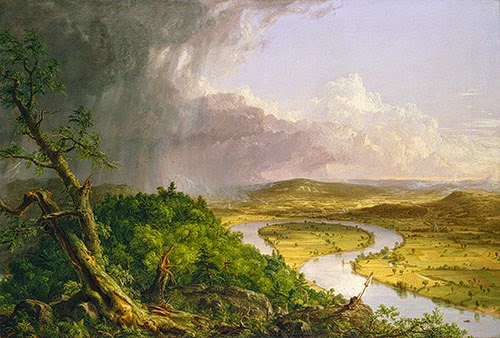This painting was done by American artist Thomas Cole in 1836, entitled 'The Oxbow', with the expanded name 'View from Mount Holyoke, Northampton, Massachusetts, after a Thunderstorm.'
The most striking thing here is the visualisation of the vast landscape, done in much depth with a lot of detail. The juxtaposition of the right half and the left half is clear. The right half represents the East, being of new settlers and westward expansionists. It shows a place of order and prosperity, with land for farming and living. The sky on that side of the piece is blue and clear, without a hint of the storm, again showing that this area pristine and perfect, almost saying that no harm will come to the people there, and even if something bad does happen (the storm) then they will fight and still remain after, a place of tranquillity. Obviously the left half of the work, the West, is the opposite of this. An unkempt wilderness, with broken trees and rugged forests, plagued by a darkness that looks almost evil, something that the East must conquer and freed from. It looks like a less extreme depiction of heaven versus hell, and in the context of the white, Christian settlers. However the battle is between wilderness and civilisation instead.
Cole stated how he painted this in response to criticism that Americans didn't fully appreciate their surroundings. He actually put himself into the piece, showing him painting the eastern side, displaying that he is an American producing American art of the American landscape. He explicitly paints the two sides at war. This shows how one cannot exist whilst the other does, a prelude to westward expansion, where settlement conquers the natural wilderness, and as a result not full meet in the painting.
There are many things we would associate with the American West that are missing: Native Americans, Animals etc. However this was a piece solely created to amplify and appreciate the natural land, so it's understandable that these things would be left out, possibly giving hints at an underlying ideology towards these aspects. That of second-class and unimportant. But, overall the piece is a great example of how many settlers would have seen the land in front of them, and could also show what influence this kind of art would have on said people.

No comments:
Post a Comment